The spinal cord serves as a conduit for sending signals and messages from the brain to all parts of the body. The spinal cord is a complex system that is part of everything we do. If the spinal cord is damaged, the message from the brain cannot get through leaving the affected area unable to move or function.
Spinal cord injuries are one of the most dangerous injuries as they can lead to paralysis or life threatening conditions. According to research, approximately 17,000+ new cases of spinal cord injuries occur each year in the United States. A spinal cord injury can happen to anyone at any age but the majority of the injuries occur in people between 16 to 30, and male account for about 80% of the new cases.
This article contains an overview of spinal cord injuries, their causes, types, levels, treatments, and tips to prevent them from happening.
A spinal cord injury refers to the damage to the spinal cord resulting from sudden blow, trauma, disease, or degeneration. Depending on the severity, people with spinal cord injuries may lose essential function or mobility in different parts of the body.
A damaged spinal cord can affect:
There are different ways injuries happen and can have different causes. In most cases, spinal cord injuries can be categorized into two types:
“Complete” spinal cord injuries are the most serious and occur when the patient has lost all the feeling (sensory) and all the ability to control movement (motor function) below the injury site.
“Incomplete'' spinal cord injuries are increasingly common and occur when the patient has some sensory or motor function below the injured site. Because the spinal cord is partially-compromised, injuries may vary from person to person depending on the severity.
The spinal cord is divided into 4 sections: cervical, thoracic, lumbar, and sacral. Learn each section of the spine, the level injury, and severity:
This type of injury affects the head and neck area above the shoulder. The higher the level of injury on the spinal cord, the more severe it can become. Therefore, this is the most severe level of spinal cord injury.
This type of injury usually affects the abdominal muscles, upper chest, and mid-back of the body. With this level of spinal cord injury, arms and hand function are usually normal.
This type of injury mostly affects the legs and hips. With this level of injury, patients may need braces or wheelchairs in order to move.
This type of injury affects the buttocks, pelvic organ, hips, and the back of the thighs. With this level of spinal cord injury, patients are most likely able to walk and function.
If a spinal cord injury is not easily recognized, a more severe injury may occur. There are symptoms that may occur immediately, while some may come gradually.
Some of the possible symptoms of spinal cord injuries include:
The symptoms described above may look like other medical conditions or problems. So, if you suspect someone has a spinal cord injury, keep the person still and call for medical help.
Neuro rehabilitation centers are available to provide proper treatment and on-going care for people suffering from spinal cord injury.
In the United States, motor vehicle accidents are the leading cause of spinal cord injuries in younger individuals, while fall is the leading cause for people over 65. Other reported causes of spinal cord injuries includes:
A spinal cord injury is a serious medical condition that requires comprehensive evaluation, treatment, and rehabilitation. The recovery time depends on the severity of the injury. The initial treatment may include medication, surgery, and other medical procedures while long-term treatment plans include on-going care and rehabilitation programs.
Read more about spinal cord injury rehab.
Though it’s impossible to prevent spinal cord injuries, there are general safety practices you can do to reduce your risks of getting one, or the people around you.
Some risk-reducing measures include:
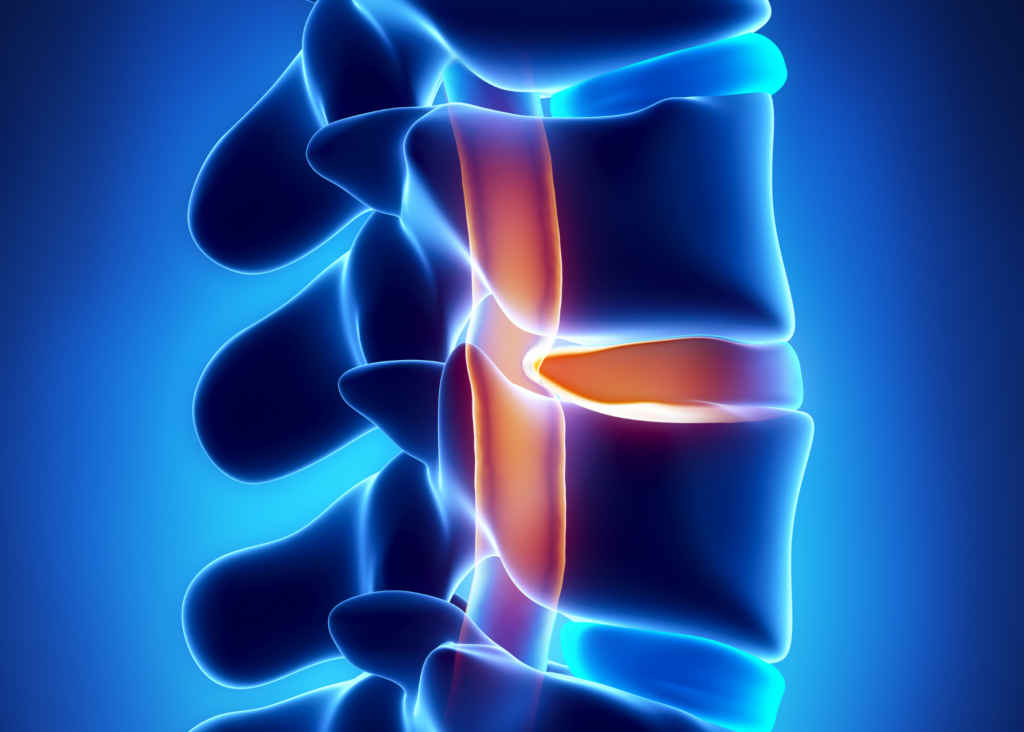
If you’re looking for a patient-centered rehab for you or a loved one, then you’re on the right track!
At NeuLife, we provide effective and research-based rehabilitative services to address your serious issues. Your care will be based entirely on your injury, situation and body, designed around your capabilities and proceeding at your speed. Your physical and mental health will be addressed, as the therapy covers a myriad of topics, from diet and nutrition, to relationship skills, to occupational therapy.
Besides spinal cord injury rehabiliation, we also provide other types of rehabilitative treatment, such as:
Contact us now at 800-626-3876 to learn more about our programs or schedule a tour to see our stunning in-patient facility.
The material contained on this site is for informational purposes only and DOES NOT CONSTITUTE THE PROVIDING OF MEDICAL ADVICE, and is not intended to be a substitute for independent professional medical judgment, advice, diagnosis, or treatment. Always seek the advice of your physician or other qualified healthcare providers with any questions or concerns you may have regarding your health.
A traumatic brain injury, or TBI, refers to a medical condition wherein the brain sustains injuries that can cause physiological damage and disruption in its normal function. Traumatic brain injuries usually occur following a direct blow or violent jolt to the head caused by a traumatic accident.
Since TBI drastically affects brain function, it is considered as one of the leading causes of acquired disability in the US. Individuals sustaining a traumatic brain injury can either die from the injuries or experience lifelong debilitating symptoms, such as:
But having a brain injury should not define one’s narrative. There’s more to a person than their disability, and that is the ultimate message that we need to vocalize this Brain Injury Awareness Month.
As a major cause of death and disability in America, there’s still a lot that we don’t know about traumatic brain injury. So in participation with the #MoreThanMyBrainInjury campaign, here’s a rundown on five interesting facts about traumatic brain injury.
Experts refer to traumatic brain injury as a public health epidemic as it is the most common cause of disability and mortality in teens and adults. Studies suggest that more than 2% of the general population in America are living with a disability as a consequence of a traumatic brain injury.
Furthermore, research has found that there are an estimated 100,000 individuals who die from traumatic brain injury yearly, while 500,000 are reported to be permanently disabled. A study also stipulated that every 15 seconds, there is an individual who suffers or sustains a brain injury.
All these statistics only point to one thing: that brain injury is a public health problem that is failed to be recognized by many. In fact, only 1 in 3 Americans knows the term brain injury and its long-term effects.
CT scans and MRIs are used to get a detailed view of the brain from several angles. These diagnostic imaging tests also show a complete picture of the brain so doctors can see if there are any abnormalities, such as bleeding, bruising, fractures, and other types of acute trauma.
However, not all types of brain injuries and damage may be seen in scans. In fact, for most traumatic brain injuries, about 80% cannot be seen on a CT scan or MRI.
An individual sustaining a TBI can have a clear scan but still show warning signs of a TBI, such as a concussion or impaired cognitive, behavioral, and psychological function.
That’s why doctors usually diagnose TBI using imaging tests together with other diagnostic procedures, such as neurological evaluation, the Glasgow Coma Scale, psychological testing, and others.
A concussion is a type of traumatic brain injury that causes short-term, temporary disruption or loss of normal brain function. It usually lasts for a few minutes and happens after a bump, direct blow, or sudden jolt to the head. Most doctors often consider concussion as a mild traumatic brain injury.
Despite being dubbed as “mild” and “not life-threatening”, a concussion still causes psychological injuries to the brain, such as:
These changes may seem minute compared to other injuries, but they can still affect the physical, mental, and cognitive abilities of a person. So patients with mild TBIs should still take caution as its effects can become serious over time, especially without the right interventions.
A traumatic brain injury, no matter how mild, can cause changes in the structure and chemical composition of the brain. As a result, this can affect how a person thinks, learns, feels, and acts, thus altering mood, behavior, and personality.
This can then lead to the development of mental health symptoms and mental disorders. Some examples include depression, anxiety disorder, and bipolar disorder. TBI can also lead to the worsening of an underlying mental illness, which can increase the chances of suicidal ideation. So it’s important to include mental health counseling and therapy in a patient’s treatment plan or follow-up care.
Recovery from a traumatic brain injury may take time. Some studies suggest that there’s a significant chance of recovery if treatment starts within the first one to two years following the TBI.
However, in reality, time does not actually indicate a patient’s chance for recovery. Favorable outcomes during one’s healing process will depend on the type of therapies included in a patient’s treatment plan. It should be a combination of the following:
Improvement and a good prognosis are possible as long as there is consistency, commitment, and ample support from the best neuro rehab facility.
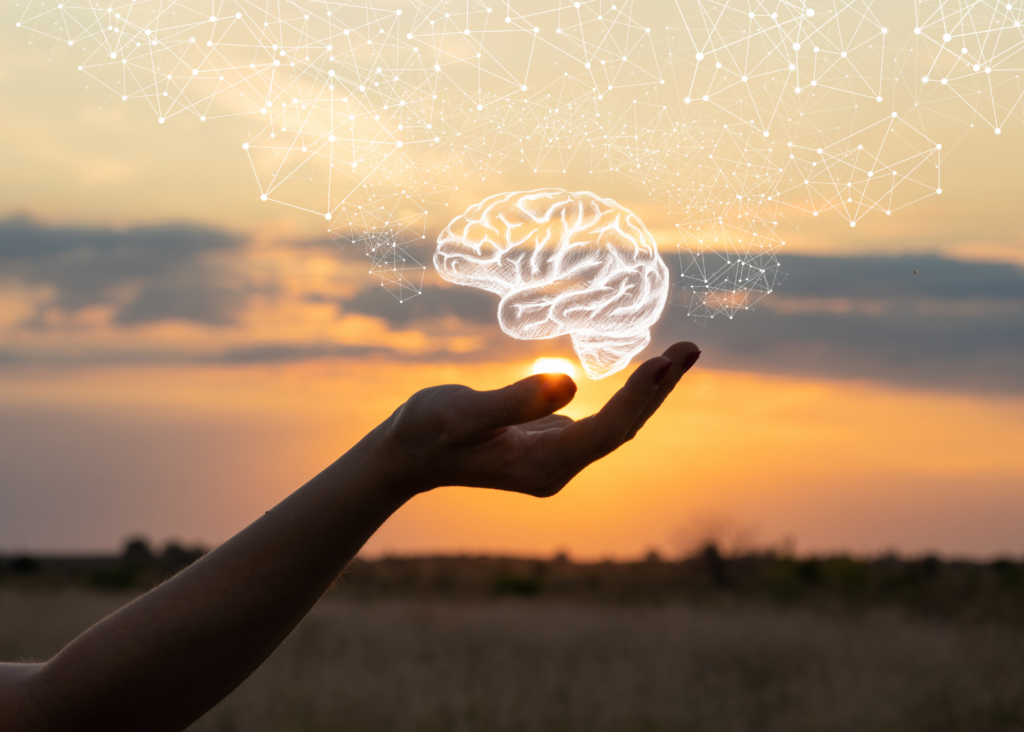
Neulife Rehabilitation believes in the power of evidence-based treatment and therapy. There’s still hope in achieving maximum independence and function through our comprehensive neuro rehab services with the help of our trained team of healthcare professionals.
We specialize in providing the best rehab for brain injury and patients sustaining spine injuries, amputation, orthopedic injuries, stroke, catastrophic injuries, and other neurological disorders. Learn more about our residential rehab facility by contacting us at 800-626-3876.
The material contained on this site is for informational purposes only and DOES NOT CONSTITUTE THE PROVIDING OF MEDICAL ADVICE, and is not intended to be a substitute for independent professional medical judgment, advice, diagnosis, or treatment. Always seek the advice of your physician or other qualified healthcare providers with any questions or concerns you may have regarding your health.
Brain injury refers to a medical condition characterized by impaired brain function. It is usually caused by a violent blow or sudden jolt to the head.
Traumatic brain injuries can affect each patient differently. But one thing’s for sure一it can cause debilitating and life-altering effects on one’s physical, mental, and emotional well-being.
Furthermore, a brain injury can change how a person functions, thinks and behaves. This means that your loved one might need to rely on you to perform simple day-to-day tasks. They will need your help to cope and adjust to their new way of living.
Living with someone with a brain injury may be hard at first since you’re clueless about what you can do to help them.
Here are 8 simple ways to better care for a loved living with a brain injury and how to make their life easier despite their condition.
The first course of action for every loved one or family caregiver should be to educate themselves about the disease. Learning about brain injury allows you to understand its symptoms and effects, thus helping you prepare for the changes that may happen in the future.
Knowing these things will help put things into perspective and make it easier for you to tackle the day-to-day challenges of living with someone with a brain injury. Here are some ways how you can learn more about the condition:
Furthermore, knowing more about TBI can help you prevent some of its symptoms from exacerbating by adapting healthy strategies and activities.
Patients suffering from a traumatic brain injury can experience various physical symptoms. Some examples include mobility problems, general weakness, loss of balance, and sensory problems. Additionally, TBI can also affect their cognitive function, causing them to experience memory problems.
So, it would greatly help their cause if you take on the responsibility of doing some of their everyday duties. You can show your support by offering to drive them to and from their appointments, run their grocery errands, or take on some of their house chores.
Before your loved one comes home from the hospital, it’s vital to make some changes in your home environment. Make sure to consider their current abilities and limitations in rearranging the place to make it a safer space.
Here are some of the best ways to improve home safety while also encouraging independence and mobility:
If they are staying in a 24/7 inpatient facility, you can make their space homey by placing family pictures or bringing familiar items with them.
According to studies, memory impairment is a common complaint for many patients with mild to moderate traumatic brain injury. People with such conditions can have difficulty remembering things and retaining new information, such as their appointment schedules, important occasion, or the location of their keys.
As a result of memory problems, your loved one may feel confused most of the time, which can lead to stress and frustration. You can prevent these situations by helping them be organized to provide a sense of normalcy and control over their life. Some of the best ways to do these include:
Help your loved one as much as possible but be careful so as not to seem controlling or condescending.
After hospital treatments, people with TBI may be advised to continue therapy and rehabilitation in inpatient facilities or at home. However, your loved one may experience difficulties when it comes to initiating rehab exercises on their own.
So, the best way to help them is to encourage rehabilitation by providing assistance or offering to perform exercises with them. You may also offer to accompany them to and from their therapy sessions.
These seemingly simple things can have a huge impact on your loved one and may encourage them more to attend their therapy.
A traumatic brain injury may impair your loved one’s physical and mental capabilities. But this does not mean that they should spend their days confined to their bed or room. It’s still important for them to expand their comfort zone and maintain social relationships.
One healthy way to do this is to gently encourage them to go out or try new activities. Start with something simple such as inviting them to sit with you on the porch or accompany you while you do gardening.
Once they warm up to the idea of going out, you can set up activities they can enjoy. This can include a trip to somewhere quiet and peaceful, like a secluded park or riverside. You may also arrange a simple gathering with a few close friends or loved ones, such as brunch or a BBQ at home.
Damage to the frontal lobes can cause several mental and behavioral issues, such as mood swings, irritability, and lack of empathy. It may also be challenging to control their negative emotions, especially during specific triggers, such as frustration, exhaustion, or overstimulation.
So if your loved one ever gets unreasonably angry or irritated, it’s best to stay patient and avoid reacting negatively. Don’t take these outbursts personally since, more often than not, it's just the result of a problem that they have a hard time coping with.
When these things happen, you can try to figure out and resolve the source of their frustrations. You may also try to reassure and comfort them. Sometimes, letting them have alone time for a few minutes can also help. Just remember to stay supportive and compassionate during these trying times.
There’s no playbook on how to cope with brain injury for both patients and loved ones. But it’s undeniable that emotional support plays a crucial part in one’s overall recovery. Showing support in the simplest ways (e.g., being with them every day, validating their emotions) can make a big difference in their rehabilitation process.

The road to recovery from a brain injury is not an easy journey for both patients and loved ones. But these hardships are only temporary with the help of the best team of therapists at NeuLife.
NeuLife offers one of the best rehabilitative services and residential post-acute programs in the area. We strive hard to give your loved ones the best care and treatment plans so they can achieve the highest level of functionality and independence.
We provide various services, such as
And more!
Contact us now at 800-626-3876 or schedule a tour to visit our residential and 24/7 inpatient rehab in Florida.
The material contained on this site is for informational purposes only and DOES NOT CONSTITUTE THE PROVIDING OF MEDICAL ADVICE, and is not intended to be a substitute for independent professional medical judgment, advice, diagnosis, or treatment. Always seek the advice of your physician or other qualified healthcare providers with any questions or concerns you may have regarding your health.
Brain stem injury is a rare condition that can happen to anyone, regardless of age and health. It has a set of debilitating symptoms that can drastically decrease one’s quality of life. Fortunately, there are now plenty of rehabilitative treatment options that can help bring back the body’s lost functions and abilities.
Read on below as we discuss everything you need to know about brain stem damage, including its causes, symptoms, and specific treatment options.
The brainstem is a stalk-like feature that can be found at the base part of the brain. Its primary function is to connect the brain to the spinal cord, sending signals from the brain to the rest of the body.
The brainstem is a neural pathway made up of three regions: the midbrain, pons, and medulla oblongata. These regions consist of critical nerve bodies (e.g., cranial nerves) responsible for controlling the body’s subconscious functions. This includes the following:
Therefore, preserving the integrity and health of the brainstem is of utmost importance since it regulates the body systems responsible for survival.
Brainstem damage usually occurs as a result of an underlying disorder or complications to one’s current medical condition. Some examples of diseases or conditions that can affect the brainstem include:
Encephalitis refers to the inflammation of the brain tissues caused by an infection or autoimmune disorder. When areas of the brain start swelling, it can put pressure on the brainstem and force it to push against the skull. As a result, the brainstem may sustain some injuries and get damaged over time.
The disease does not necessarily need to target the brainstem itself. It can affect other parts of the brain, which in turn, can affect the brainstem as its surroundings become inflamed.
An ischemic stroke occurs when a blood clot forms along the vessels that supply blood directly into the brainstem. This obstruction can cut off blood and oxygen supply to the brain, damaging the affected areas, including the brainstem. Over time, severe oxygen deprivation can lead to critical problems, such as comatose or brain death.
A brain tumor refers to the irregular or abnormal growth of cells within the brain. Whether benign or malignant, brain tumors can cause severe damage to the brain since it’s growing inside a very restricted space. As it takes up space inside the skull, the tumor can increase the pressure inside and even push against the brainstem, causing neurological damage over time.
Furthermore, the tumor will also hog all the oxygen and nutrient supply in the brain, robbing the brainstem of such vital resources.
A traumatic brain injury happens when one sustains a violent bump, blow, or jolt to the head. It may also be the result of a foreign object penetrating the brain. Any of these can cause damage to the brain as it can cause a violent shift inside the skull, causing tissue damage or axonal injury.
This happens when an artery breaks, disrupting the healthy flow of blood into the heart. When the heart fails to pump oxygen into the brain, tissues and nerve cells will die, thus impairing the brainstem.
Damage to the brainstem can cause various symptoms that can be debilitating and life-threatening. Some injuries may instantly cause irreversible damage to the brainstem, which can then lead to brain death.
A brainstem damage can have varying symptoms depending on the cause of the injury and its severity. Some patients may also experience the physical manifestations immediately after the trauma, while others may take up to a few days before seeing the effects of the injury.
Generally, patients with a damaged brain stem may experience one or more of the following:
The brainstem controls the body’s vital functions and relays neurologic signals for other systems to function. So it’s no surprise that a damaged one can have crippling effects on almost every part of the body.
Fortunately, it’s still possible to recover from such a condition with the right rehabilitation and treatment plan.
A damaged brainstem is considered an emergency and should be treated immediately. Generally, the doctor will provide emergency care first to address immediate concerns, such as oxygen treatment, stopping the bleeding, or stabilizing the neck.
The physician may also perform an emergency surgery to address the main cause of the brainstem injury. Some examples include the surgical removal of a blood clot, removing a tumor, or repairing a skull fracture.
Once the patient is stable, the next course of action is to undergo rehabilitation. Rehabilitative therapy allows patients to recover from the symptoms of their condition and regain their normal body functions. Plus, it will help them adapt to their new level of physical state and abilities.
Some forms of therapy that might be included in your treatment plan are:
During rehab, you will be working with various healthcare professionals who will assist you throughout your recovery journey. Once your normal body functions are restored, you may be advised to go home and continue rehabilitation at home.

If you or a loved one needs a high-quality inpatient rehabilitative facility, then look no further.
NeuLife Rehab provides one of the best post acute rehab programs accredited by the Commission on Accreditation of Rehabilitation. Our individualized programs and services are structured to meet the varying medical needs and desired goals. Every treatment plan we create aims to help patients achieve their highest level of independence and function.
Contact our post acute rehabilitation center at 800-626-3876 to learn more about our diverse programs, such as
We are more than happy to answer your questions and concerns. You can also schedule a tour.
The material contained on this site is for informational purposes only and DOES NOT CONSTITUTE THE PROVIDING OF MEDICAL ADVICE, and is not intended to be a substitute for independent professional medical judgment, advice, diagnosis, or treatment. Always seek the advice of your physician or other qualified healthcare providers with any questions or concerns you may have regarding your health.
Traumatic Brain Injuries (TBI) cause varying effects on each patient depending on the injury’s severity. Some symptoms may be temporary, while others can be more permanent. Fortunately, recovery and symptom improvement are possible in both cases through rehabilitation and therapy.
Most patients undergo a combination of physical and cognitive therapy to treat and manage the symptoms of TBI. However, this does not mean that you cannot proactively care for your brain’s health through simple yet helpful activities.
This new year, prioritize your brain function and mind health by setting new goals that can help your TBI. Here are some of the most common new year’s resolutions to stick to for a healthier brain.
Most people include “exercise more” in their new year’s resolution to improve their physique and overall physical health. However, studies suggest that exercising, specifically aerobic activities, also has a significant impact on one’s cognitive function.
According to research, regular aerobic exercises have neuroprotective effects on the brain that can improve cognitive deficits associated with TBI. Additionally, engaging in such activities can stimulate the following brain-positive effects:
Furthermore, regular exercise can also indirectly improve a patient’s mental and cognitive health by improving sleep and reducing stress and anxiety.
Besides strengthening the brain, aerobic activities may also serve as rehabilitative exercises that can benefit their physical health. Some exercises to try include walking, jogging, cycling, dancing, swimming, or enrolling in an aerobics class.
Another typical new year’s resolution, which can boost brain health, is eating a healthy and balanced diet. Patients with TBI should observe proper nutrition and consume foods that fuel the brain and promote recovery. Make sure to eat foods rich in vitamins, minerals, omega 3, and antioxidants, such as:
As the brain heals and recovers, it will use up more energy and nutrition than usual, so you need to stack up your storage by eating a balanced diet. Of course, it goes without saying that you should prevent consuming unhealthy foods high in saturated fat, preservatives, and added sugar.
Hobbies bring pleasure, cure boredom, and relieve the everyday stress that life can bring. However, plenty of studies also suggest that having a hobby or taking up a new one enhances overall brain function, especially in patients with TBI.
Post acute rehabilitation facilities, like NeuLife, include learning new hobbies and skills as part of their rehab program for its plethora of health benefits. It can help patients stay active, enhance social skills, improve their behavioral issues, and prevent cognitive decline.
More importantly, brain-friendly hobbies can stimulate neurogenesis and neuroplasticity. This allows the creation of new neural networks and pathways that can help heal brain injuries in the long run.
Of course, the best hobbies for TBI patients are those that accommodate their restrictions and physical limitations. For example, a recovering patient may stick with art or music rather than physical hobbies to ensure safety. On the other hand, patients with attention problems can start with something easy, such as scrapbooking, before moving on to other challenging activities.
Remember, full skills and competency levels may or may not return but the important thing is to enjoy and find fulfillment in what you're doing.
Nicotine from tobacco, cigarette, and e-cigarette has plenty of adverse effects on the brain and its function, such as:
Like nicotine, excessive alcohol consumption can pretty much destroy the brain as well by impairing memory, shrinking its size, and disrupting normal blood flow.
Therefore, quitting these unhealthy vices can promote faster brain injury healing and boosts recovery. Without nicotine and alcohol, your body will also be better able to avoid other neurologic conditions and cardiovascular illnesses.
It is common for patients to experience social difficulties after a traumatic brain injury. It may be due to physical or cognitive limitations caused by their condition, such as hearing impairment, speech problems, and memory issues. Other factors may include a lack of motivation, feelings of isolation, and lowered self-esteem due to their illness.
However, it’s important to maintain social ties and connections as it can help sharpen thinking skills and improve other brain functions. Additionally, it can help ward off mental health problems typically experienced by TBI patients, such as anxiety and depression.
Here are some tips on how you can improve your social skills and maintain relationships as you recover from TBI.
Traumatic brain injuries can cause various symptoms that manifest in one’s physical, mental, and psychological well-being. One such example is a patient’s exacerbated response to stress or stressors.
Studies suggest that individuals with TBI tend to respond poorly to stress. Regardless of severity, patients who suffer from TBI also suffer from poor stress tolerance due to neuroendocrine dysfunction.
Unfortunately, chronic stress only worsens traumatic brain injuries and their symptoms. Therefore, recovering patients should learn to cope with stress effectively. You can do this by practicing meditation, mindfulness, aerobic exercises, and other relaxation techniques.
All of these brain-friendly new year’s resolutions can help you overcome the symptoms of TBI. That’s why at NeuLife, we incorporate these activities (and more!) into our individualized rehab programs to promote recovery and improve quality of life.
NeuLife Rehabilitation is one of the best brain injury rehabilitation centers in Florida. Our highly trained team provides quality treatment services to patients with various neurologic and catastrophic injuries. Some of the programs we offer include:
Experience a superior standard of care by contacting us at 800-626-3876. You can also make a referral here.
The material contained on this site is for informational purposes only and DOES NOT CONSTITUTE THE PROVIDING OF MEDICAL ADVICE, and is not intended to be a substitute for independent professional medical judgment, advice, diagnosis, or treatment. Always seek the advice of your physician or other qualified healthcare providers with any questions or concerns you may have regarding your health.
Many complications can occur due to a traumatic brain injury (TBI). Some of these are noticed immediately after injury, while others may occur later in recovery. Usually, the complications depend upon the injury's location and severity. TBI rehab centers are vital as they can reduce the risk of complications resulting from a TBI
Complications can be physical or neurological and may be progressive. Understanding complications can help you to identify the best ways to support and care for your loved one.
Because every brain injury is different, patients may have unique secondary effects. These depend upon the area of the brain impacted and whether the injury is mild, moderate, or severe.
Pressure ulcers develop from injury to the skin or underlying tissue. They often occur over bony areas such as the hips or heels. Often they develop due to friction, immobility, pressure, an infection, or sepsis. Pressure ulcers can develop quickly, even within a few hours of pressure.
If not treated, they can result in tissue death and life-threatening infections. Caregivers must adjust the patient frequently (at least every 2 hours) to help avoid pressure ulcers.
TBI patients who are immobile and susceptible to developing a deep vein thrombosis (DVT). A DVT is a formation of blood clots in the large veins, usually in the legs. Part of the clot can break off, travel through the body and lead to complications such as a pulmonary embolism.
The cause of a pulmonary embolism is a blockage of the artery of the lungs. Both DVTs and Pulmonary embolisms can be life-threatening or lead to additional complications such as a stroke.
Pneumonia is an infection that affects the air sacs in one or both lungs. They can fill up with fluid or pus, which can be life-threatening. TBI patients are prone to developing pneumonia and may require a ventilator in severe cases.
It is also important to note that aspiration pneumonia is frequent among TBI patients who have difficulty swallowing (dysphagia). Symptoms of pneumonia include:
Tension and migraine headaches are common after TBIs. Headaches may be frequent for many weeks or months after the injury.
TBI, patients can experience vertigo due to inner ear problems, damage to the cerebellum or occipital lobe of the brain, medication, migraines, or due to dehydration. Vertigo or dizziness is common after a TBI. Some patients may express that it seems as if the room is spinning.
Many TBI patients experience some level of fatigue after a brain injury. Fatigue is due to the brain's recovery from the injury's secondary effects. The brain uses energy for healing, leaving less energy to engage in other tasks. Patients may also experience physical or psychological fatigue as they participate in neurological rehabilitation.
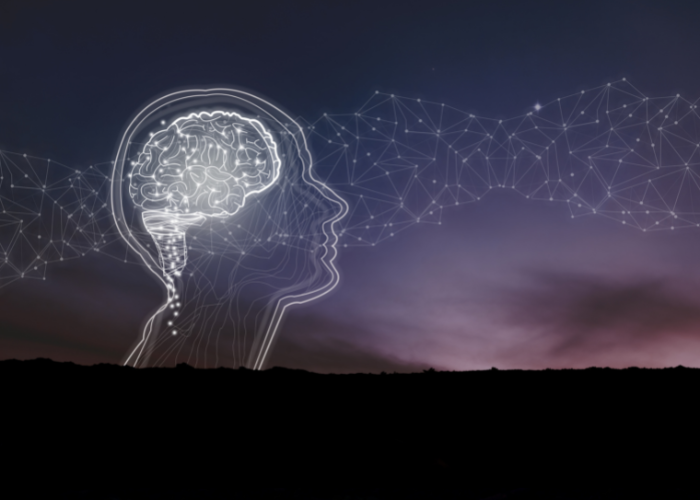
NeuLife Rehabilitation is one of the largest neuro rehabilitation centers in Florida and the southeast United States. We specialize in patients who have experienced a TBI and have a wide range of rehabilitation programs available at our facility.
We customize our programs for each patient, as each injury is unique. Our care plans are structured so that our patients can reach their highest potential for individual functioning and integrate into the community. We can only accomplish this through our clinical experts' work and experience in treating TBI patients.
Contact us to schedule a tour today!
The material contained on this site is for informational purposes only and DOES NOT CONSTITUTE THE PROVIDING OF MEDICAL ADVICE, and is not intended to be a substitute for independent professional medical judgment, advice, diagnosis, or treatment. Always seek the advice of your physician or other qualified healthcare providers with any questions or concerns you may have regarding your health.
Trauma is one of the leading public health problems that ranks as the fourth leading cause of death for people of all ages. In fact, studies suggest that there are 60 million orthopedic injuries occur yearly due to traumatic accidents, such as car collisions, sports accidents, or work-related accidents.
Regardless of its cause, most traumatic accidents result in various complex orthopedic injury that requires medical care and hospitalization. Additionally, the patient must undergo intensive physical therapy to completely recover from the injury.
Fortunately, NeuLife offers complex orthopedic injury rehabilitation for patients with severe musculoskeletal injuries. Read on to learn more about what it is and when it is recommended.
A complex orthopedic injury refers to injuries sustained after a serious condition or severe trauma. Some examples of conditions considered a complex orthopedic injury include:
refer to broken bones in the hip or pelvic area. Fractures may also be considered complex if there’s muscle, vessel, and nerve damage.
Is an autoimmune disorder wherein your body sends antibodies to attack the tissue surrounding and protecting the joint.
is a degenerative joint disorder that causes extreme joint pain and swelling. An advanced form of arthritis may happen due to a traumatic joint injury or as a complication of another underlying condition.
are congenital disabilities that affect the musculoskeletal system causing orthopedic problems as the baby grows up.
is a last resort procedure that your doctor may recommend if you have a severely damaged joint. This operation involves removing your injured joint and replacing them with artificial ones.
are injuries in the musculoskeletal system caused by a direct blow, blunt trauma, or penetrating trauma.
These injuries usually require immediate medical attention to treat the actual condition. After the treatment, your doctor will recommend a complex orthopedic injury rehabilitation to help your recovery. This type of physical therapy will help restore your body’s normal function as you heal from your surgery or condition.
Furthermore, complex orthopedic injury rehab aids in strengthening your muscles and body so you’ll gradually maximize your mobility. This therapeutic technique will also teach you to adapt and perform daily tasks without injuring yourself again.
First, your care team will perform a thorough medical evaluation to assess your current condition, mobility, and limitations. Then, they will create an individualized treatment program focused on your medical needs and personal goals.
Complex orthopedic injury rehab is primarily done in an inpatient facility to provide 24/7 extensive care and assistance to the patients. Some of the various types of therapies you may encounter in the rehab center include:
You’ll be working with a group of a multidisciplinary team that may consist of doctors, physical therapists, nurses, nutritionists, and orthopedic surgery specialists. As your condition improves, your care team will adjust your treatment plan and gradually introduce more challenging activities and exercises.
The last stage of your complex orthopedic injury rehabilitation is an effective transition of care. Your team will equip you with the right tools, devices, and learnings so you’ll be ready when you transition back to your home or on to a long-term care facility.

If you’re looking for a patient-centered rehab for you or a loved one, then you’re on the right track!
At NeuLife, we provide effective and research-based rehabilitative services to address your orthopedic problems. Our board-certified healthcare team focuses on empowering patients to overcome their physical limitations through various therapies and innovative techniques.
Besides complex orthopedic injuries, we also provide other types of rehabilitative treatment, such as:
Contact us now at 800-626-3876 to learn more about our programs or schedule a tour to see our stunning accommodations.
The material contained on this site is for informational purposes only and DOES NOT CONSTITUTE THE PROVIDING OF MEDICAL ADVICE, and is not intended to be a substitute for independent professional medical judgment, advice, diagnosis, or treatment. Always seek the advice of your physician or other qualified healthcare providers with any questions or concerns you may have regarding your health.
After a traumatic brain injury (TBI), patients can experience a number of different side effects. One of the most common is intestinal dysfunction, leading to stomach ulcers, food intolerance, or gastritis. Just as every brain injury differs, side effects can vary depending on the patient.
Though the intensity of intestinal dysfunction differs for each patient, they can be uncomfortable and impact recovery after a TBI. Fortunately, there are steps patients can assist in recovery.
The gastrointestinal tract breaks down food into nutrients used to fuel the body. It is also responsible for trapping and disposing of harmful substances, which is essential for our general health.
Many people are not aware of the strong connection between the gastrointestinal tract and the brain. They both communicate with each other to promote proper digestion through hormones and nerves.
We mentioned that brain injuries are tied to digestive problems but why? The cause and contributing factors continue to be researched.
Studies show that TBIs are related to intestinal permeability, allowing digestive substances to pass through the intestines. This can lead to high blood sugar, sepsis, and organ failure.
Some patients with a TBI can experience intestinal permeability just six hours after suffering their injury. Others may have a delayed onset, sometimes weeks or months after their TBI.
In addition to intestinal permeability, other intestinal tract issues include stomach ulcers and gastritis. Symptoms experienced can be intensified by psychological distress many TBI patient experience.
Psychological stress can affect the immune symptom, which can further cause intestinal distress. A strong immune system assists in preventing complications after suffering a TBI.
Why is a strong immune system essential? The immune system is responsible for the substances that pass through the intestinal tract, eliminating harmful substances from passing into the body.
First, TBI patients should consult with their physician or a gastrointestinal specialist to diagnose any underlying condition for a proper diagnosis. The right brain injury rehab center will have physicians that can help diagnose intestinal dysfunction.
Physicians can use medications and diet to help manage symptoms depending on the condition. A diet that boosts the immune system is vital for TBI patients.
A high-fiber diet with plenty of fruit, avocados, and lentils can be helpful for some patients. Another benefit of a more bland diet can include lean meats, beans, or carrots. These foods can be easier to digest but also have plenty of nutrients.
Patients should also avoid excessive caffeine, dairy, and greasy foods that can worsen intestinal symptoms. Proper hydration is also important, so TBI patients should drink plenty of water.
Rest is also essential for brain injury patients. It helps both the body and brain heal. With medications and a proper diet, many patients can minimize symptoms of intestinal dysfunction.

NeuLife Rehabilitation is one of the largest post-acute rehabilitation centers in Florida and the southeast United States. We offer a wide range of rehabilitation programs for patients who have suffered a catastrophic brain injury.
Our programs are customized to meet the needs of each patient. Our care plans are structured so that our patients reach their highest level of individual functioning and independence. The ultimate goal is community reintegration which is accomplished through the work of our clinical experts and our experience in treating a wide range of TBI patients.
If you are interested in our services, schedule a tour today!
The material contained on this site is for informational purposes only and DOES NOT CONSTITUTE THE PROVIDING OF MEDICAL ADVICE, and is not intended to be a substitute for independent professional medical judgment, advice, diagnosis, or treatment. Always seek the advice of your physician or other qualified healthcare providers with any questions or concerns you may have regarding your health.
Traumatic brain injury or TBI refers to an injury that damages the brain, thus disrupting its normal function. It usually happens when the head violently hits an object or when it punctures the brain tissue. You may also develop this injury when you sustain a jolt, bump, or blow to the head.
Traumatic brain injury affects patients differently. Some people may experience its symptoms right away, while others can develop it over time. Most patients with mild TBI can recover in the span of three months with medical intervention.
Unfortunately, others may experience the lingering symptoms and secondary effects of TBI over time, especially if their injury is moderate to severe in nature. So in simpler terms, a TBI can indeed get worse over time, and here’s why:
The symptoms of a TBI greatly depend on the type of injury, location of the trauma, and severity. But generally, moderate to severe brain injuries are the ones that often get worse over time, especially with delayed medical treatment.
Moreover, studies suggest that 50% of patients who suffer from a TBI will experience cognitive decline and premature mortality within 5 years from the initial trauma. Here are some of the most common reasons for the long-term consequences of a traumatic brain injury:
these changes occur in the brain hours or days after the initial head trauma. These may involve changes in the brain tissue, chemical composition, or blood vessels that may contribute to the long-term symptom of a TBI. Some examples include inflammation, hematoma, infection, and hypoxia.
injury to the cells and tissue can gradually lead to the generation of reactive oxygen and reactive nitrogen species in the brain. These substances cause oxidative stress, which leads to irreversible neuron damage.
damage to the brain’s long nerve fibers or axons tends to cause subtle changes in its structure. As a result, it can lead to prolonged and progressive functional disturbances in the brain. Some examples of axonal changes include abnormality in axon growth or fiber sprouting.
apoptosis is the scientific term for programmed “cell death,” which only happens when there’s cellular damage. However, studies suggest that specific pathways (intrinsic and extrinsic) get triggered in TBI, stimulating delayed apoptosis even in healthy brain cells.
acute changes in blood flow have been observed immediately after the initial insult. However, studies have also suggested that cerebral blood flow changes may still occur months after the trauma. Some examples of detrimental changes that can aggravate the initial TBI include reduced blood flow and coagulopathy problems.
Additionally, delayed and improper medical treatment can also contribute to the worsening of a TBI. Without rehabilitation, symptoms will worsen, thus making you vulnerable to life-threatening complications.
Having a traumatic brain injury should be your life’s endgame. There are plenty of techniques and activities you can do to prevent the gradual decline of your brain’s function. This includes the following:
Besides the initial medical treatment, it’s important for patients to receive continuing therapy and rehabilitative support to stave off TBI-related cognitive decline. Moreover, rehab will play a major role in helping you regain your strength, body function, speech, and social skills.
Additionally, therapy will teach you how to adapt to the permanent changes in your body without further injuring yourself. Some examples of rehabilitative treatment that you may encounter when you enter an inpatient neuro rehab near me are:
Rehabilitation also includes mental and emotional support to address any mental health issues that may arise following the traumatic brain injury.
Patients suffering from TBI have a higher risk of developing other diseases, such as diabetes, hypertension, and cardiovascular illnesses.
But by adapting a healthier lifestyle, you can dodge these life-threatening bullets while also helping your brain recover from its injury. Some specific brain-boosting activities you may want to start now include:
Like the physical body, the brain also needs exercise to keep it in shape and maintain or regain its normal function. This is why rehabilitation facilities like NeuLife, emphasize the importance of brain stimulation by including it in their programs.
Some examples of stimulating activities that can improve your brain function and cognition include:
Remember to take it easy, though. It’s okay if you cannot memorize a list of tasks right away or get every crossword square right. With consistent practice and stimulation, you’ll be able to regain your mental prowess.
Studies suggest that patients with traumatic brain injury are more vulnerable to stress. They may find it challenging to manage stress due to the symptoms and effects of their injury. Unfortunately, stress only worsens TBI symptoms and may cause the patient to develop mental health issues if not addressed.
Meeting people with the same circumstances and life experiences provides encouragement and support. It gives patients and families a solid support system to help them through the highs and lows of traumatic brain injury recovery.
Furthermore, your support group will become your safe haven where your feelings and struggles, which may sometimes feel like minor, are validated.
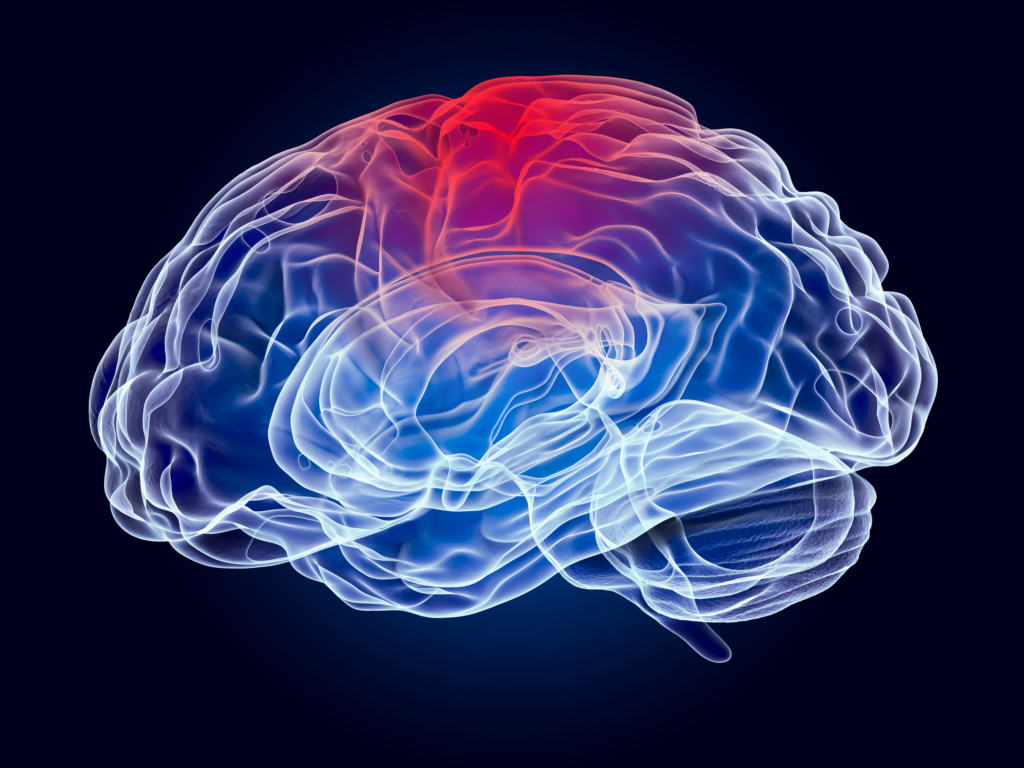
NeuLife Rehabilitation is one of the leading rehabilitation facilities in Florida, specializing in treating various conditions一from catastrophic injuries to neurologic conditions. Our healthcare professionals provide the highest quality of patient care and medical services, such as:
Give us a call at 800-626-3876 to learn more about our services.
The material contained on this site is for informational purposes only and DOES NOT CONSTITUTE THE PROVIDING OF MEDICAL ADVICE, and is not intended to be a substitute for independent professional medical judgment, advice, diagnosis, or treatment. Always seek the advice of your physician or other qualified healthcare providers with any questions or concerns you may have regarding your health.
People who have insulin-treated diabetes are at risk for severe hypoglycemia-induced brain injury. Hypoglycemia destroys neurons by depriving them of the necessary glucose to function.
Both hypoglycemia and hyperglycemia can cause brain injury, but the damage it does to the brain differs. Hypoglycemia is considered more dangerous. It can cause permanent damage in a short amount of time.
Although it’s rare, brain injuries can also cause diabetes, and symptoms of diabetes can worsen after a traumatic brain injury (TBI). A brain injury can also make diabetes more difficult to treat.
Brain injuries can cause neuroendocrine disorders, which can sometimes lead to the development of type 2 diabetes. Also, TBIs can exacerbate the symptoms in patients who already have diabetes.
The reason behind this is that after an injury, the body releases stress hormones. Stress hormones make the body less sensitive to insulin which can cause blood sugars to rise, leading to hyperglycemia. You must treat hyperglycemia quickly as it can lead to cognitive deterioration and even death.
Both Hyperglycemia and hypoglycemia can result in life-threatening brain damage when left untreated. In severe cases it can cause a diabetic coma. Also, hypoglycemia can cause a diabetic seizure, causing additional brain damage.
The best way to manage diabetes is to keep blood glucose levels under control. Patients must monitor glucose so it does not go too high or too low. Patients can usually accomplish this through lifestyle changes and insulin injections.
Those with type 1 diabetes need regular insulin injections because the body does not produce insulin naturally.
Type 2 diabetic patients can usually manage symptoms through diet and exercise. Exercise is very important because it helps burn up extra glucose to stabilize sugar levels. Some patients with type 2 diabetes do need to take injections to keep blood sugar levels under control.
In TBI patients, treatment is more complicated. Patients can sometimes forget to monitor and give themselves insulin injections, so they need assistance from family and friends to remind them to check their levels regularly. Patients in neuro rehabilitation centers have staff who monitor glucose levels and administer insulin accordingly.
Other helpful options to help TBI patients monitor glucose levels include setting a timer. There are also continuous glucose monitors that can alert if levels get too high or too low. Insulin pumps also read glucose levels and administer insulin automatically. All of these options can help TBI patients control their diabetes effectively.
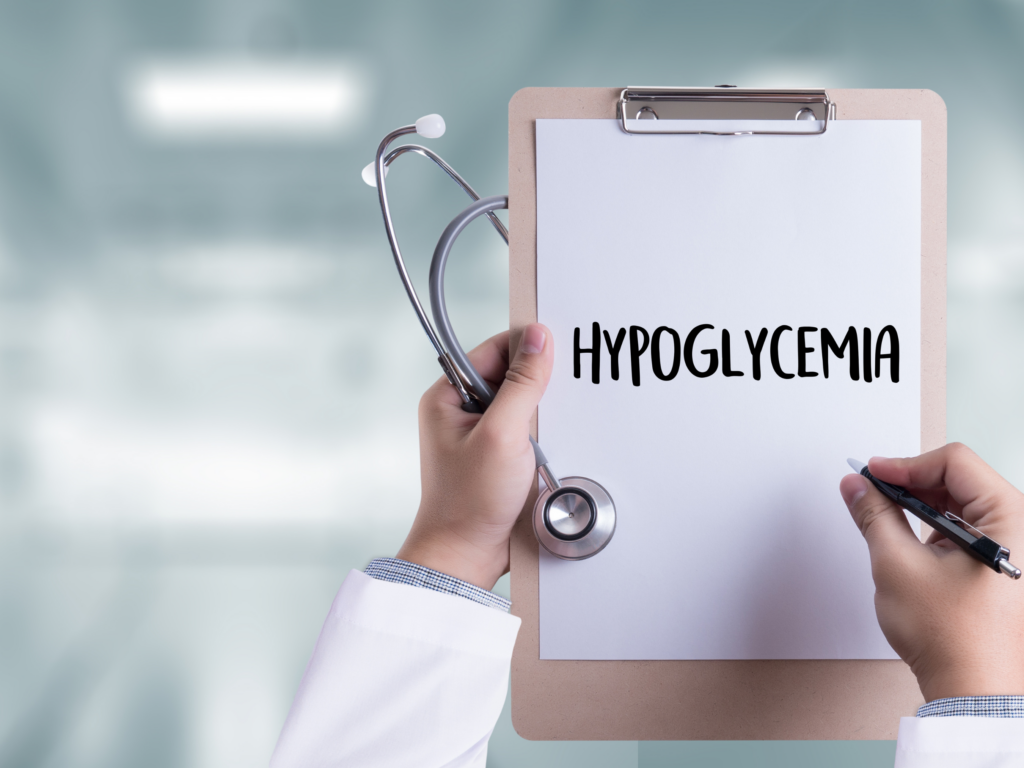
If your loved one requires post-acute rehab, you can benefit from our services at Neulife.
Our rehabilitation center is one of the largest located in Florida. We have experience treating patients with various medical conditions, including diabetes.
We have a reputation for being one of the best neurological rehabilitation centers because we focus on a wide range of injuries and treat all patients on an individual basis.
So, if you are looking for a traumatic brain injury rehab near you, then look no futher — NeuLife looks forward to being part of your loved-one’s recovery.
Call us or make a referral through our convenient online form. You can also schedule a tour to visit our traumatic brain injury long term care facility.
The material contained on this site is for informational purposes only and DOES NOT CONSTITUTE THE PROVIDING OF MEDICAL ADVICE, and is not intended to be a substitute for independent professional medical judgment, advice, diagnosis, or treatment. Always seek the advice of your physician or other qualified healthcare providers with any questions or concerns you may have regarding your health.
Traumatic Brain Injury (TBI) rehabilitation centers understand the importance of recreational activities in recovery. For one, it provides for fun and engagement with other patients. Recreational activities also stimulate the brain and help to restore functioning.
Patients may have some difficulties with certain activities they used to love. However, several options can be beneficial in recovery. These help TBI patients to move forward so they can go back to the activities they have enjoyed in the past.
Puzzles and board games not only improve cognitive skills, but they are fun. It allows for the opportunity to engage with other patients adding the benefit of social engagement. Activities such as checkers or chess are excellent board games for TBI patients.
Puzzles are also fun and provide social engagement when patients work on the puzzle together. Puzzles help patients with problem-solving skills and memory, which are essential in traumatic brain injury rehabilitation.
Creativity stimulates the brain, improving memory and fine motor skills. Painting is beneficial for TBI patients as it enhances creativity. Painting also helps with concentration which is important in brain injury rehabilitation.
TBI patients may also struggle with depression. Painting helps to manage these feelings as there is a sense of accomplishment after finishing a project.
Many TBI patients love animals. Through spending time with service animals, patients with feelings of depression or anxiety can find relief. Many service dogs are trained to help TBI patients by assisting with physical support and assistance in daily living. Animal therapy is a wonderful activity that offers fun for TBI patients undergoing neuro rehabilitation.
Music therapy can help patients with skills such as language and cognition. Music stimulates the brain, promoting healing for TBI patients in rehabilitation. Patients benefit from listening to music and may also see benefits through singing or playing instruments. These activities can support cognition and memory.
Gardening is a fun outdoor activity for TBI patients. Patients enjoy being outdoors as it improves feelings of depression. Gardening is also an activity that patients can do as a group, enhancing social interactions. Patients also can find relief from stress and anxiety by participating in an activity where they are out in nature.
It is essential to have a healthy diet after a TBI as the brain requires nutrition to heal. Cooking can be a fun activity that helps patients learn about nutritional foods that are helpful in their recovery.
Though cooking may be a challenge for some brain injury patients, loved ones can help patients, so they receive help with recipes and stay safe while cooking. Cooking has the added benefit of improving memory and the patient's cognitive skills.
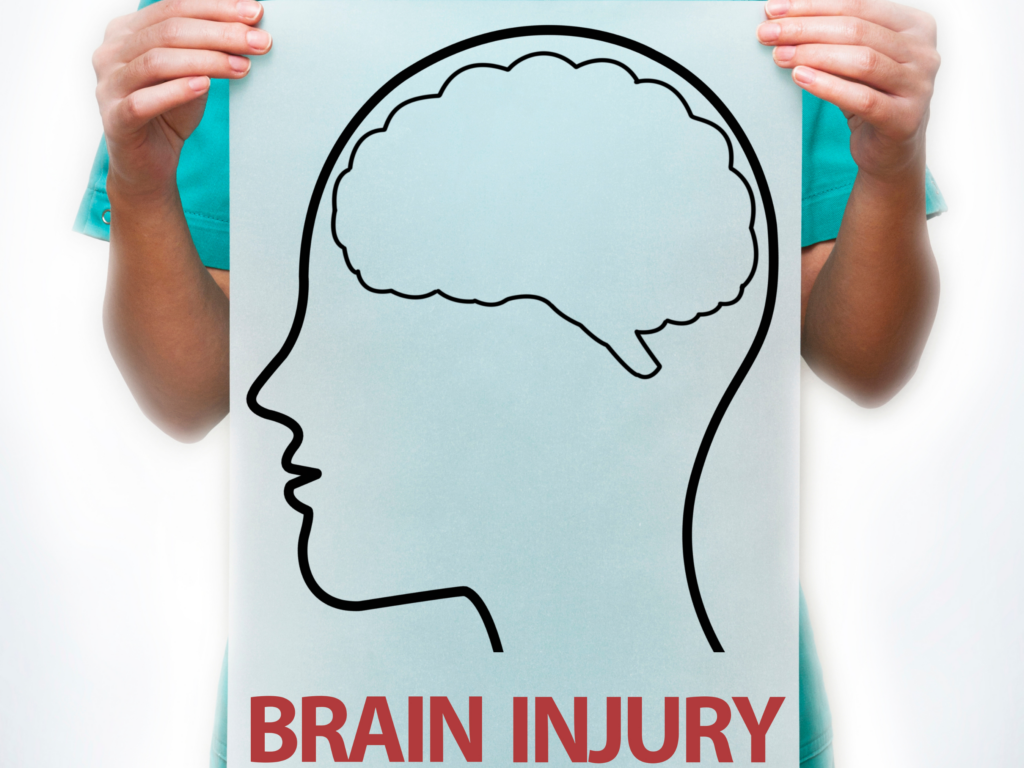
Neulife Rehab provides post-acute rehab that is patient-focused. We offer treatment through a combination of therapies, including recreational activities that may improve our patients’ quality of life.
Neulife is one of Florida's most extensive brain injury facilities, offering traumatic brain injury rehabilitation through medical management, mental health services, occupational and physical therapy, and cognitive therapies.
We use a patient-centered approach to help patients manage symptoms and accomplish their rehabilitation goals.
We not only focus on the needs of our patients but also their families. We assist our patients by providing clinical evaluations, medical care, and therapeutic activities, including those that address perseveration.
You may also schedule a tour to see if our facility is appropriate for your loved one. Have additional questions? Reach out to us at 1-888-626-3876, or make a referral.
The material contained on this site is for informational purposes only and DOES NOT CONSTITUTE THE PROVIDING OF MEDICAL ADVICE, and is not intended to be a substitute for independent professional medical judgment, advice, diagnosis, or treatment. Always seek the advice of your physician or other qualified healthcare providers with any questions or concerns you may have regarding your health.
Head trauma can cause several different symptoms一from vomiting and persistent headaches to loss of consciousness or seizures. It can also cause various types of post-traumatic movement disorders that are usually harmless but can still bring psychological and emotional distress to the patient—one such example of a movement disorder after head trauma is tics.
Read on below for an in-depth discussion on tic disorder and how inpatient brain injury rehabilitation can help treat this condition.
Tics refer to involuntary, spasm-like muscle contractions that happen in specific areas of the body. This, in turn, results in sudden and repetitive body twitches, jolts, or sounds.
Normally, a tic disorder is not a cause for concern since they’re fairly common in children five years of age. In fact, studies suggest that 10% of children develop transient tics during their early school years. Fortunately, such conditions improve and resolve themselves naturally over time.
The onset of tics during adulthood can be rare. There are many possible causes, including genetics and secondary tourettism. But in some cases, the sudden appearance of a tic disorder may be linked to prior head trauma or traumatic brain injury.
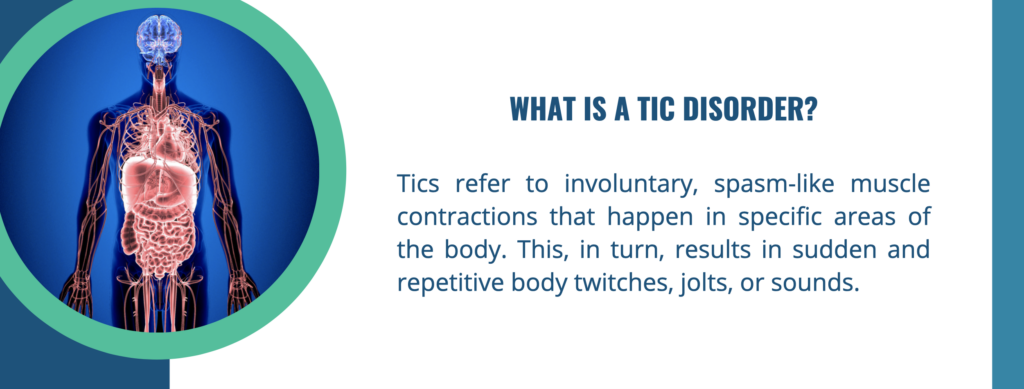
Tics following a head injury are known to occur in some patients suffering from moderate to severe TBI. According to studies, about 13% to 66% of patients with severe traumatic brain injury developed some kind of movement disorder, including tics.
As of now, science has yet to discover the exact cause of a tic disorder. However, research indicates that multiple factors may influence the onset of tics after head trauma. This includes the following:
After a head or brain injury, patients may experience tics days or weeks after the incident. However, there are reported cases wherein tics develop only after a year post-TBI.
Tics start as a strong and unpleasant urge to carry out a specific movement or vocal tic. This sensation builds up in the body and may only be relieved once you do the tic. Some people may suppress this urge, but doing so can cause significant stress and tension.
There are many types of tic disorders which may be classified based on their symptoms and the kind of movement they present. For example, a tic may either be:
Tic disorders may also be classified depending on the symptoms the patient exhibits. This includes the following:
Motor tics refer to uncontrolled movements involving one or more muscle groups, specifically in the eyes, mouth, face, neck, and shoulders. They can either be simple (fleeting and meaningless gestures) or complex (patterned movements). Some of the most common symptoms of this condition are:
Tic disorders that develop after a head injury usually affect the head and facial muscles first. Over time, it may also affect other muscle groups in the body.
Vocal or phonic tics are unintentional and often meaningless sounds or phrases uttered by someone with a tic disorder. Typically, it only involves simple sounds made from the nose and mouth, such as grunting, sniffing, snorting, throat clearing, and barking. However, this is not always the case.
Patients with complex vocal tics may actually utter specific words, phrases, and sentences. They are usually spoken in a louder tone and often happen at the beginning or during a conversation. Some examples include:
Although harmless, vocal tic disorders usually cause psychological and emotional stress to the patient due to the stigma associated with them.
Tourette’s syndrome is a more severe variant of a tic disorder that involves both motor and vocal tics. This condition is usually inherited genetically, but research suggests that head trauma may increase one’s risk of developing Tourette's syndrome.
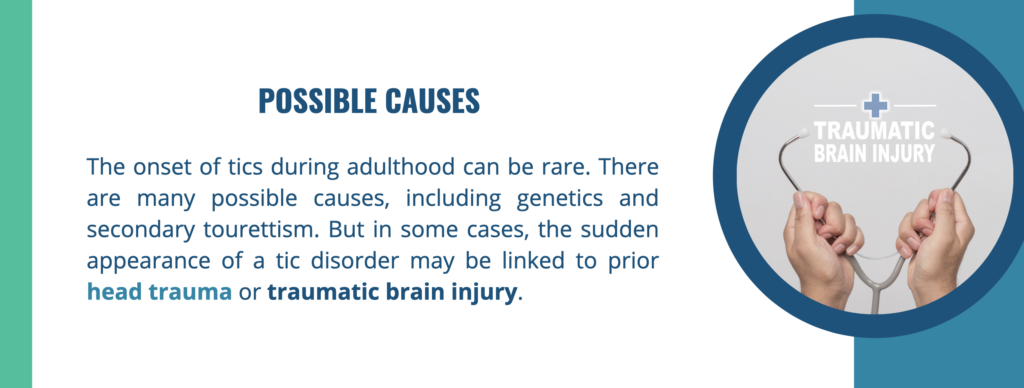
Tics due to TBI may not be life-threatening, but they can cause severe emotional trauma, social problems, and even mental health problems. It can also disrupt everyday activities and may cause harm to the patient or another person. Doctors usually treat tic disorder using different approaches, such as:
Habit reversal therapy (HRT) refers to a therapeutic technique used to treat unwanted behaviors, habits, and tics. Doctors and physical therapists usually use this therapy as the first line of defense against tic disorders. HRT is comprised of four stages:
HRT and other cognitive behavioral therapy can also help a patient recover from their head injury or traumatic brain injury.
ERP refers to a behavioral therapy that exposes the patient to thoughts and situations that usually trigger their tic disorder while in a safe environment. Through the guidance of an expert therapist, you will confront your triggers and do your best to avoid your compulsive tics and behaviors.
ERP exercises allow patients to get used to their triggers or the unpleasant sensations that come before a tic behavior. As a result, they’ll be able to tolerate these urges and work their way through them without doing the tic.
Doctors can also prescribe some medications combined with ERP or HRT therapy. According to studies, some examples of drugs that can help manage tic disorders include antipsychotics (haloperidol), SSRIs, tricyclics, dopamine blocking agents, and alpha 2 agonists.
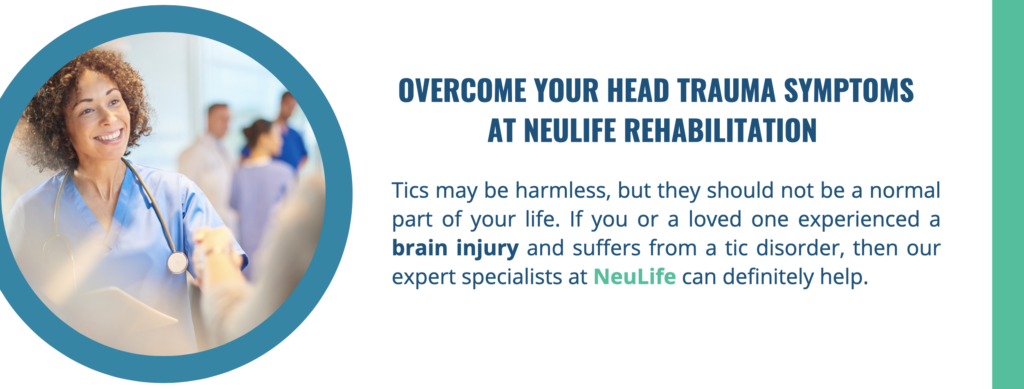
Tics may be harmless, but they should not be a normal part of your life. If you or a loved one experienced a brain injury and suffers from a tic disorder, then our expert specialists at NeuLife can definitely help.
NeuLife Rehabilitation is one of Florida's leading providers of quality rehabilitative services. We use a patient-centered approach to meet the current abilities, medical needs, and goals of each of our patients. Some of the programs and services we offer include:
And more!
Each of our programs is designed to treat your symptoms, help you recover from your injuries, and aid you in transitioning seamlessly into the community.
If you think you or someone you know can benefit from our services, don’t hesitate to call us at 800-626-3876. We are more than happy to answer your questions and concerns. You can also schedule a tour.
The material contained on this site is for informational purposes only and DOES NOT CONSTITUTE THE PROVIDING OF MEDICAL ADVICE, and is not intended to be a substitute for independent professional medical judgment, advice, diagnosis, or treatment. Always seek the advice of your physician or other qualified healthcare providers with any questions or concerns you may have regarding your health.

We know that choosing the next step in your recovery from a catastrophic illness or injury is complex. Together, we can help you take the next step.
Contact us with any questions today.